Hydroaviation of the Japanese submarine fleet in World War II. Part IX
Along with the development and creation of submarine aircraft carriers for the Japanese fleet, work was underway on their aviation component - shock onboard seaplane.
The very idea of using strike aircraft launched from large special submarines-aircraft carriers to attack targets on the Pacific coast of America, the continental United States or in other remote areas of the world’s ocean, appeared in the Marine General Staff of the Imperial Fleet of Japan (Kaigun Gunreibu) for several more months before the outbreak of war in the pacific. This idea is reflected in the specification under the code name "Maruyan", which was prepared by Kansei Hombu.
The command of the Japanese fleet believed that the success of the mission of the submarine aircraft carrier to deliver a surprise attack on the strategic goal would largely depend on the characteristics of the aircraft, as an integral part of a single strike complex.
To avoid interception by enemy fighters, a strike aircraft without external suspensions had to reach a maximum speed of 4000 nodes (300 kilometers per hour) at an altitude of 555 meters. The maximum range of his flight was to be at least 800 nautical miles (1482 kilometers), while initially it was assumed that this would be a “one-time” aircraft and he did not need floats (there is nothing to carry ballast for three seas!).
On an underwater aircraft carrier, strike aircraft in the amount of three units were to be placed folded (and not disassembled) in an airtight cylindrical hangar with a diameter of 3.5 meter and a length of 34 meter.
All these requirements of the Japanese fleet to the new aircraft found a formal expression in the specification of the "17-Shi Experimental Marine Attack Bomber", adopted by 15 May 1942 of the year. By this time, the parameters of the underwater aircraft carriers of the “Sen-Toku” type had been completely clarified and agreed upon, which made it possible to begin practical work on creating a strike aircraft for them.
The development of a fundamentally new aircraft was entrusted to Aichi, which, starting from 1920-s, created aircraft exclusively for the Japanese Navy. The representative of the Aichi company Takushiro Gomei (Takuichiro Gomei) was appointed the head of the project to create a striking seaplane, and Norio Ozaki became the chief engineer.
Despite the stringent requirements of the “17-Shi” specification, the project management considered the task of creating an aircraft-compliant aircraft specification quite feasible. The project itself received the brand designation "AM", and the developed strike aircraft - М6А1. Only fourteen months after the start of development, he was given his own name “Seiran” (Seiran), which in a simplified translation from Japanese means “Mountain Fog”. The traditional code name from the allies "Seyran" is not received, the Americans learned about its existence in the last days of the war.
Work on the project went slowly, however, despite its innovative nature, were planned, progressive. At the initial stage, in order to speed up the work, an attempt was made to adapt the commercially produced Aichi D4Y1 Susyi diving bomber to be placed in the aircraft hangar of an underwater aircraft carrier and to equip it with floats (if necessary). In addition, the unification of components and assemblies would greatly simplify the production and maintenance of the new aircraft.
Deck dive bomber "Yokosuka" D4Y2 "Susy" with liquid cooling engine "Atsuta-32", 1944 year
However, this idea had to be abandoned. “Susi” installed on the starting carriage didn’t fit into the dimensions of the hangar due to the large screw. It was considered inexpedient to make the screw removable, as the time for preparing the aircraft to start increased. For takeoff with the help of the D4Y1 catapult, a large lift force and, accordingly, a large area and powerful wing mechanization were required. The combat load (500-kg bomb) was placed on the dive bombard in the bomb bay, however it was not possible to fit the bomb or 800-kilogram torpedo required by the assignment of the 850-kg.
It became clear that you need to create a new plane, albeit with an eye on the Susi D4Y1. In addition to the excellent aerodynamic forms from the dive bomber, his 1400-strong 12-cylinder liquid-cooled engine “Aychi” Atsuta-32, which was a licensed copy of the German Daimler-Benz DB 601A, borrowed it. To provide a better view to the pilot and reduce the center of gravity, the V-shaped engine was installed on the M6А1 in an inverted position. The liquid engine, filled with hot water and heated oil, still in the hangar (before the boat ascended to the surface) warmed up much faster during launch (compared to the air-cooled engine), reducing the total time to prepare for the launch.
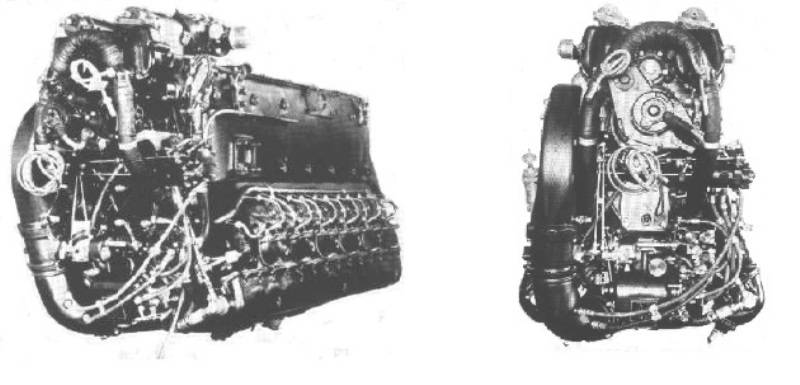
1400-strong 12-cylinder liquid-cooled engine "Aychi" "Atsuta-32" in the assembly for the attack aircraft M6A1 "Seyran" (front view and rear view)
However, the serial production of Aichi Atsuta-32 aircraft engines was launched only at the end of 1943 of the year. The first Aichi model of Atsuta-21 appeared to be installed on the first Seyran prototypes ( 1400 horsepower, but were less reliable), later replaced by regular "Atsuta-32". The first modification of dive bombers, scouts D4Y1-C / D4Y1 «Susey" 1200-equipped with powerful engines' Atsuta-12 ", and 32-I model is set at the next modification - D4Y2 (the fastest of all the" Sousse).
To ensure sufficient lift in the ejection take-off, the M6A1 received an advanced wing flap system, tested on the prototype of the Aichi developed at the same time by the ship-based reconnaissance aircraft N16A1 Zuiun (“Zuiun -“ The Favorite Glove ”). Double-slot dural flaps, deflected and turned by 90 degrees, when diving performed the function of air brakes.
Ship-based reconnaissance seaplane "Aychi" Е16А1 "Zuyun"
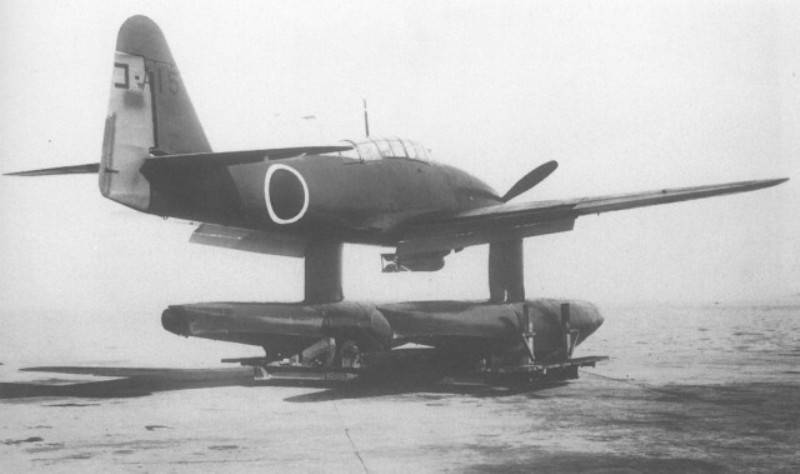
The Seyran prototype demonstrates powerful wing mechanization, similar to the Aichi E16A1 “Zuyun” seaplane
From E16А1 "Seyran" borrowed and all-metal floats. They were attached to the wing consoles by free-carrying streamlined pylons and could be dropped in flight, if necessary (at high speed, break away from the pursuing fighters).
At the stage of elaboration of requirements, the floats were considered redundant. However, later “sober heads” concluded that it was impermissible to create “one-time strike aircraft”, which, after performing the main combat mission, could participate in attacking targets in other regions (block navigation in the area of Cape Horn or strike the continental part of USA).
In addition to the floats and flaps, Zuyun shared its keel and tail fuselage with the M6-X1. The keel was a bit tall (the “Seyran” did not fit into the submarine hangar) and the ending had to be cut off.
One of the first prototypes МХNUMXА6 (front view)
In June, 1942, on a full-scale wooden layout, began developing the technology of folding wing consoles, tail units and placing the M6А1 in an aircraft hangar. As a result, a scheme was adopted (similar to that used by the Grumman company on American planes), which initially turned the wing consoles 90 counterclockwise, and then pressed against the fuselage toward the tail. This was preceded by folding the horizontal tail down and deviation of the tip of the vertical tail to the starboard. After folding, the total width of the Seyran was 2.46 meters, and the total height of the aircraft on the launch car did not exceed the 2.10 meter, which, with a screw diameter of 3.2 meters, made it possible to place it in a cylindrical aircraft hangar with a diameter of 3.5 meters. When the I-400 (“Sen-Toku”) underwater aircraft of the three “Seyrans” were stored in the hangar, the rudder was rejected as much as possible to reduce the overall length. For ease of assembly in the dark, structural elements at the junctions were painted with luminous paint. Removable floats on a submarine were stored in special sealed containers.
Layout of А6М1 in the aviation hangar of a submarine on the launching trolley
On the layout, all operations, of course, were performed manually. On real planes, a hydraulic mechanism was used for these purposes. Averaged calculations showed that after an ascent, a team of four people could assemble an airplane without installing floats in 4.5 minutes, it took 2.5 minutes to attach the floats. In practice (after the launch of the strike seaplane), the actual launch time of the I-400 submarine after the ascent of all three Seyrans took at least 45 minutes, and for I-14 with its two M6XXUMX, this figure was 1 - 30 minutes.
Structurally, the M6X1 "Seyran" was a two-engine single-engined two-float all-metal monoplane. Wooden were just the tips of the wings. The control surfaces were covered with linen. Wing fuel tanks contained 934 liters of aviation fuel.
The prototype of the M6A1 "Seyran" impact seaplane with 250-kg bomb under the fuselage
The crew of the Seyran consisted of a pilot and a gunner-radio operator (observer) and was housed in tandem in a glass-enclosed cockpit with two sliding sections.
Initially, the M6А1 small arms were to consist of two 7.7-mm machine guns - one for the course and one for the turret of the gunner-radio operator at the rear of the cab. In the end, on the basis of expediency and weight saving, it was decided to limit one defensive 13-mm machine gun Type 2 to the turret, which was a version of the German aviation machine gun MG 131.
The strike weapon of the Seyran could consist of one 850-kg of aerial torpedo Type 91 Mod. 2, suspended under the fuselage, or one 800-kg or two 250-kilogram bombs. To reduce the time to prepare for combat flight, the aircraft in the aircraft hangar of the submarine aircraft carrier were housed with suspended strike weapons. The rest of the ammunition for strike aircraft on submarine aircraft carriers of type I-400 was stored in a special cellar in one of the compartments. In total, four 6-mm aircraft torpedoes, three 1-kg and twelve 450-kg aircraft bombs were intended for armament of M800А250 "Seyran" airborne torpedo bombers.
In January, 1943 of the year, almost simultaneously with the laying of the first I-400 submarine aircraft of the Sen-Toku type, in Aytoku (in the Nagoya region), the Aichi plant began building the first six M6-X1 prototypes. The assembly of the first prototype of the aircraft was completed in November 1943 of the year, and in December, its flight tests began. In February, 1944, the second prototype of the Seyran, was put to the test.
In the guise of a new aircraft with elegant aerodynamic outlines, the features of the high-speed dive bomber "Yokosuka" D4Y1 "Susy" ("Judy") and reconnaissance hydroplane "Aychi" Е16А1 "Zuyun" were guessed.
In the course of flight tests, the prototype М6А1 confirmed the requirements for it. The maximum speed at an altitude of 4000 meters was 439 km per hour, cruising at an altitude of 3000 meters - 277 km per hour. Landing speed did not exceed 115 km per hour. The practical MX6X1 ceiling was equal to 9000 meters, and the normal flight range was 1100 kilometers. The tests revealed unsatisfactory travel stability, which was a typical problem for many float planes for its time. The problem was eliminated by increasing the height of the keel (folding part of it).
The third prototype of the M6А1 "Seyran" torpedo bomber on a transport trolley, under the fuselage 800-kg aerial bomb
By June 1944, four more prototypes М6А1 were built. Two of them were equipped with a wheeled landing gear retractable in flight and dual controls and they were intended for advanced flight tests and training purposes. The aircraft received the designation М6А1-К and the primary name "Seyran-Kai", which was later replaced by "Nanzan" (Nanzan - "South Mountain"). The wings of the wing and tail assembly at Nanzan did not fold, and the keel turned out to be truncated — it was carried out without a folding part (this did not affect track stability in the absence of floats). М6А1-К retained attachment points to the starting trolley, which made it possible to perform training launches from the “coastal catapult”.
The prototype "Seyran" with a wheel chassis "Aychi" М6А1-К "Nanzan"
Equipped with “Atsuta-32” М6А1-К “Nanzan” engines developed at a height of 3000 meters maximum speed 575 km per hour, cruising speed at the same height was 295 km per hour, the practical ceiling (9600 meters) and the range (F 1120 km).
With dual control М6А1-К, "Nanzan" was used to prepare pilots for "Seyrans", practical bombing and torpedo dumping
Satisfied with the course and test results of the prototypes М6А1, the command of the naval aviation of the Japanese fleet decided to start mass production. At the plant in Eitoka near Nagoya already in the spring of 1944, in the conditions of the strictest secrecy, preparations were made for serial production. Serial submarine impact seaplanes were designated as M6А1 Model 11 "Seiran".
“Aichi” М6А1 “Seyran” in the exposition of the National Museum of Aviation and Cosmonautics of the Smithsonian Institution, Virginia, USA
Preparation for the production of the first batch of production aircraft completed by October 1944 year. Before the devastating earthquake in the Nagoya region, 7 December 1944 managed to collect only four "Seyran". Due to the great destruction and loss of some of the most important equipment, the plant in Eytoku suspended the release of aircraft (damage was already received by the already built "Seyrans"). It was only possible to restore production by the spring of 1945. 12 in March, the plant in Eytoku was raided by American aircraft - the production of aircraft again stopped. Subsequently, production plants were subjected to attacks by enemy aircraft three times (May 17, June 26 and 24 July 1945 of the year), serial production was out of the question.
The only surviving (restored) copy of the Aichi M6А1 “Seyran” strike aircraft from the exposition of the National Museum of Aviation and Cosmonautics, Virginia, USA, today
The fleet received 14 serial M6А1 Model 11, assembled at Eytoku plant - this number was enough to equip the four 1945 submarine aircraft carriers (I-400, I-401, I-13 and I-14 by the end of March). Another six seaplanes were able to be assembled at the remaining production capacities of other aircraft building factories of the Aichi company from previously produced units, parts and components. The last Seyran was assembled in July 1945. These planes entered service with coastal-borne squadrons. Restore the full production of a specialized strike aircraft in the prevailing realities of wartime, it did not make sense.
In total, of the attack aircraft ordered by the fleet 44 (based on the equipment of the submarine aircraft carriers built at the shipyards), only 20 serial "Seyrans" were delivered. The total number of constructed МХNUMXА6 taking into account the prototypes (of which two М1А6-К) was 1 units.
The main tactical and technical characteristics of the shock Japanese seaplane "Aichi" МХNUMXА6 "Seyran"
References:
1. Beshanov V.V. Encyclopedia of aircraft carriers / Under the general editorship of AE Taras - Moscow: AST, Minsk: Harvest, 2002 - (Library of military stories).
2. Platonov A.V. Linear forces of the submarine fleet - SPb .: Galeya Print LLC, 1998.
3. Dashyan A.V. Ships of the Second World War. Japanese Navy (part of 2). Maritime collection №7, 2004.
4. Ivanov S.V. Submarines of Japan 1941-1945. War at sea (No. 31) - Beloretsk: ARS LLC, 2006.
5. Okolelov N.N., Shumilin S.E., Chechin A.A. Submarine aircraft carriers of the Japanese fleet (history, design, aircraft armament). Maritime collection №7, 2007.
6. Kascheev L.B. Japanese submarines in World War II. Maritime collection №2, 2011.
7. Firsov A. Aviation of Japan in the second world war. Part One: Aichi, Yokosuka, Kawasaki. Aviation collection №4. TsAGI, 1996.
8. Solomonov B., Kulagin K. Submarine aviation of the Yamato country. Aviamaster №3, 2003.
9. Doroshkevich O. Airplanes of Japan of the Second World War - Minsk: Harvest, 2004.
10. Chechin A., Okolelov N. Start from under water. Model designer №7,8 -2009.
11. Chechin A., Okolelov N. Sinister "Mountain Fog". Seaplane Aichi M6A "Seiran" and its predecessors. Magazine "Aviation and Time" No. 04 - 06, 2013.
12. Haruk A.I. Attack aircraft of the Second World War - attack aircraft, bombers, torpedo bombers - M .: Yauza; Eksmo, xnumx.
13. Haruk A.I. All seaplanes of the second world. Illustrated color encyclopedia - M .: Yauza; Eksmo, xnumx.
14. Kotelnikov V. Aviation in the Second World War. Aircraft of France. Part-1 (Aviation collection No. 10) - 1996.
15. Kozyrev M., Kozyrev V. Aviation of Axis Countries in World War II - M .: ZAO Tsentpoligraf, 2010.
16. Bryukhanov A. Deck aircraft in World War II: An Illustrated Collection. Parts I - IV. - Publishing solutions (licensed by Ridero), 2017.
17. Bryukhanov A. Japanese submarine aviation in World War II: Publishing solutions (licensed by Ridero), 2017.
18. Gusev A.N. Submarines for special purposes. Built ships and unrealized projects - M .: MORKNIGA, 2013.
19. RJ Francillon. Japanese Aircraft of the Pacific. Putman & Company. London-1970.
20. Robert C. Mikesh. Aichi M6A1 Seiran, Japan's Submarine-Launched Panama Canal Bomber (Monogram Close-Up 13) - Monogram Aviation Publications. Commonwealth Press Worcester, Massachustts, 1975.
21.Japanese Military Aircraft Illustrated. Vol. 3, Reconnaissance Flying Boat Trainer/Transport - Bunrin-Do Co. Ltd., Tokyo 1983.
22. Robert C. Mikesh & Shorzoe Abe. Japanese Aircraft 1910-1941. Putnam Aeronautical Books, London, 1990.
23. Famous airplanes of the world №47. Imperial Japanese Navy Reconnaissance Seaplane - BUNRINDO Co.Ltd, Tokyo 1994.
24. Tadeusz Januszewski. Japanese Submarine Aircraft - Red Series (No. 5103). Mushroom Model Publications, 2002.
25. Ryusuke Ishiguro, Tadeusz Januszewski. Kugisho E14Y GLEN: The Aircraft that Bombed America (White Series) - MMPBooks, 2012.
26. ER Johnson. United States Naval Aviation, 1919-1941 - Aircraft, Airships and Ships Between the Wars. Mcfarland, 2011.
Internet resources:
http://www.airwar.ru;
http://www.warbirdphotographs.com;
http://wiki.gcdn.co;
http://silverhawkauthor.com;
http://www.flickriver;
http://www.latoff.com;
http://yosikava.livejournal.com.
To be continued ...
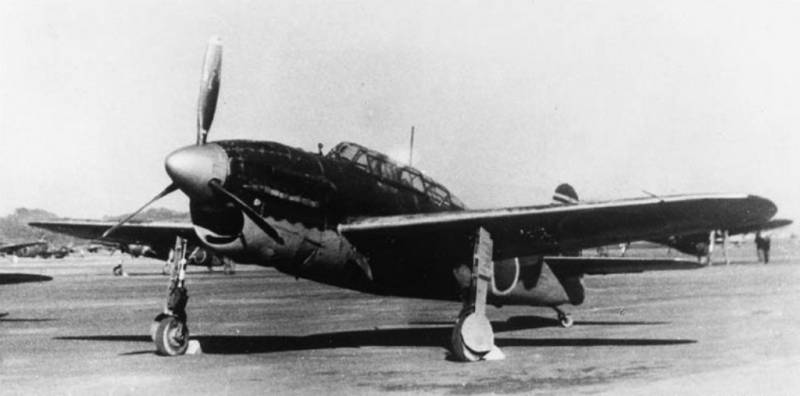
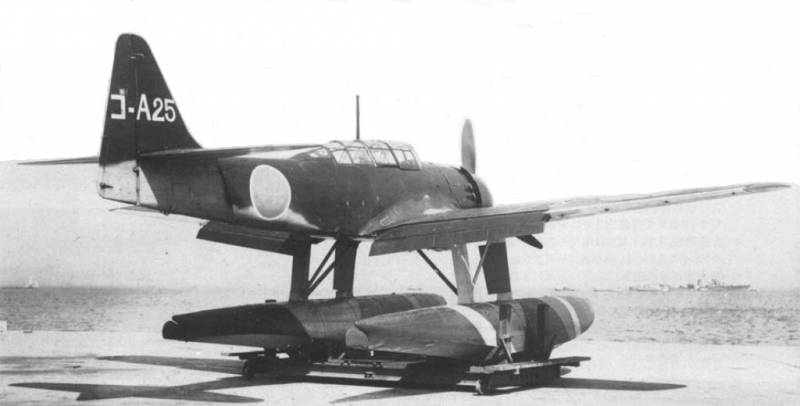
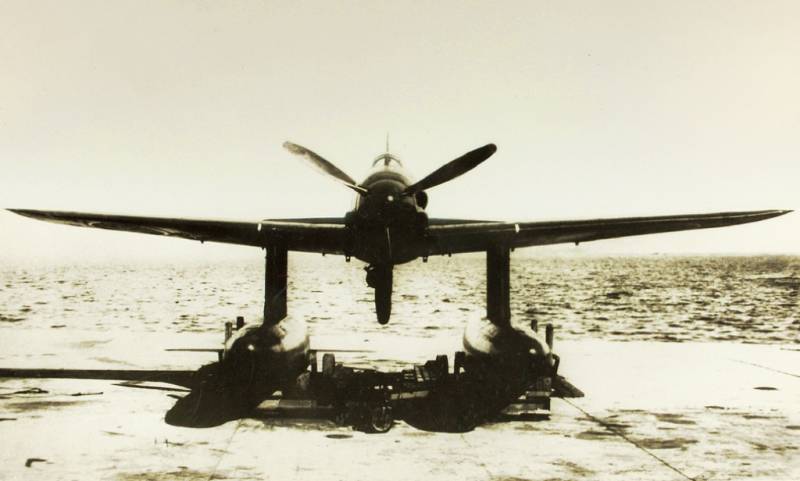

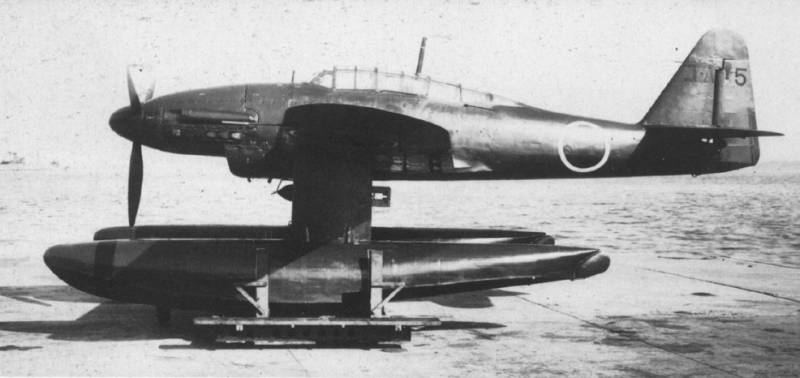
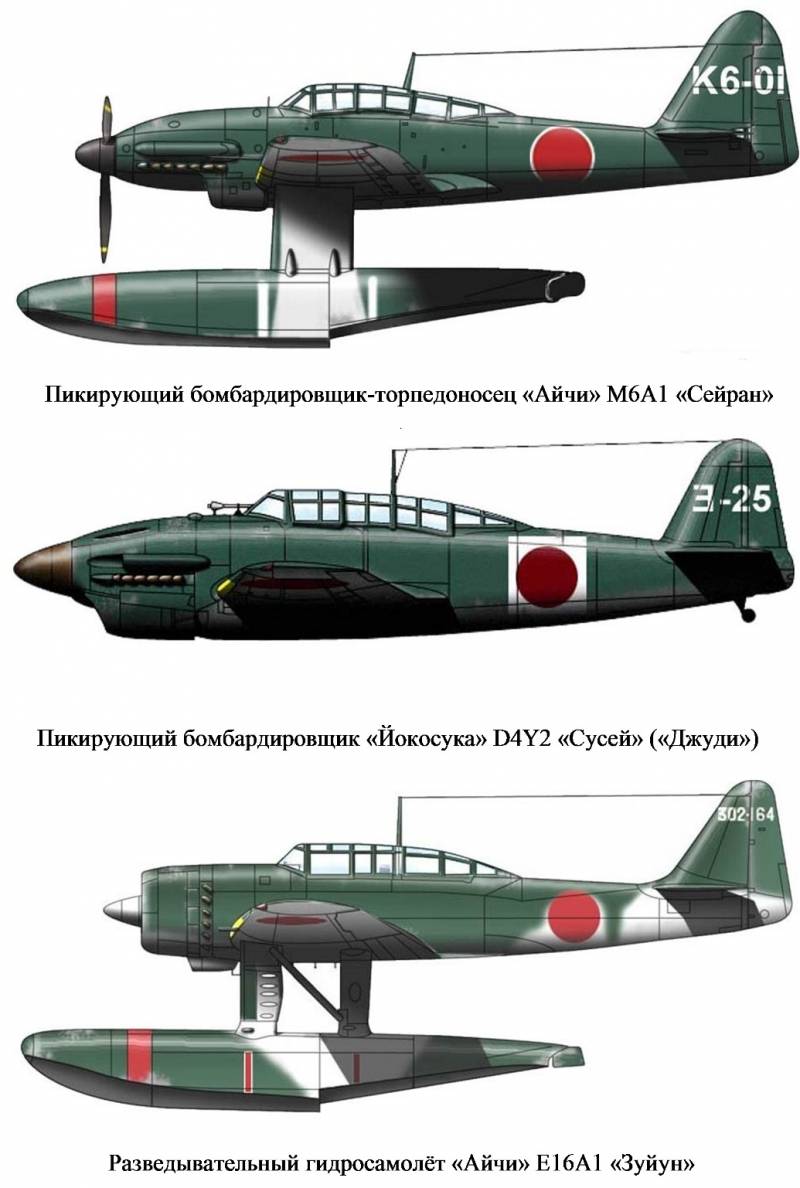
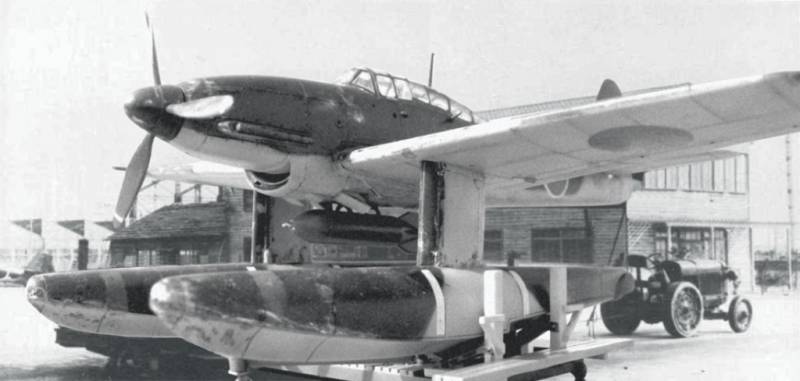
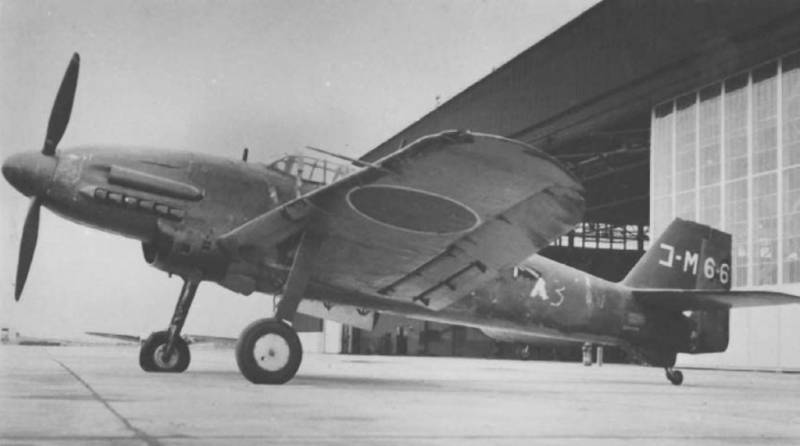
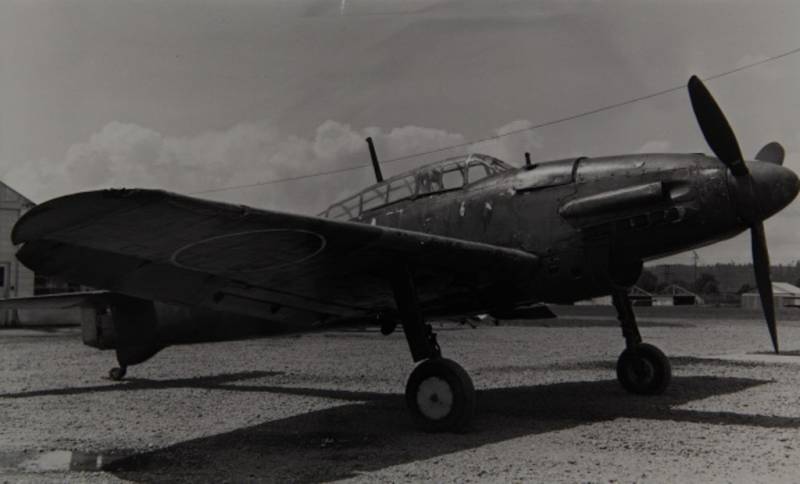
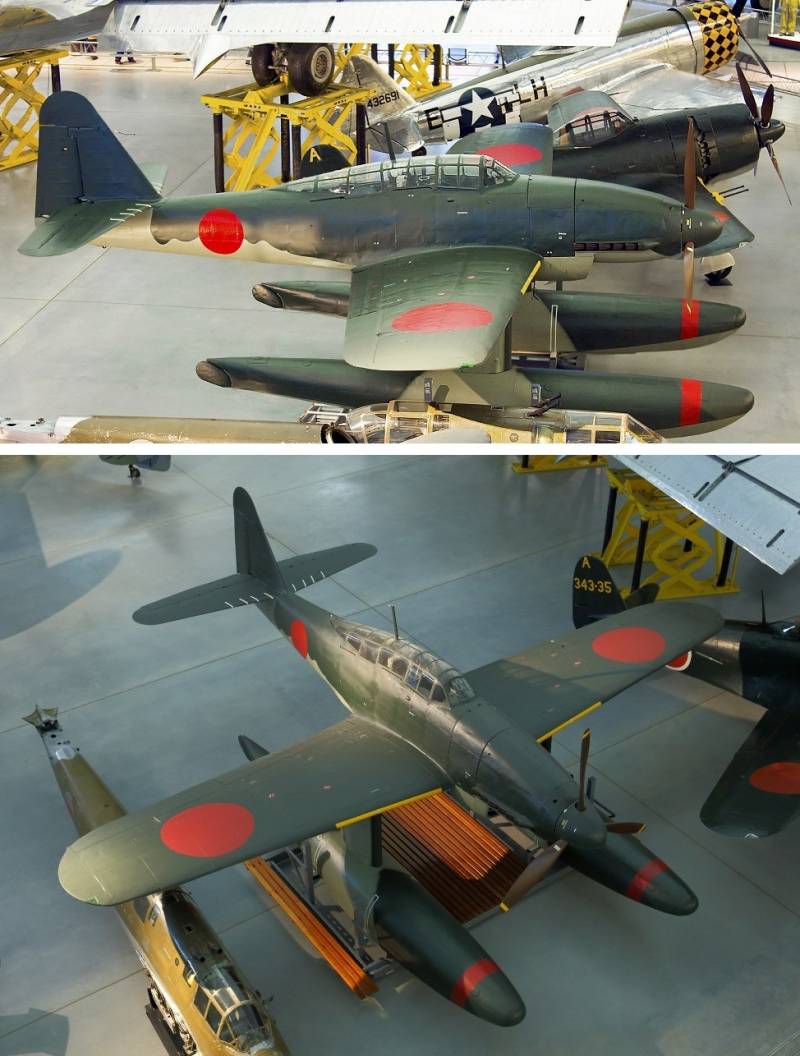
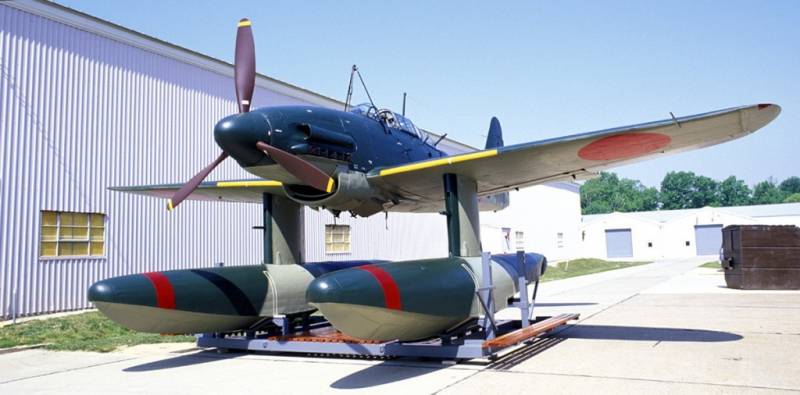
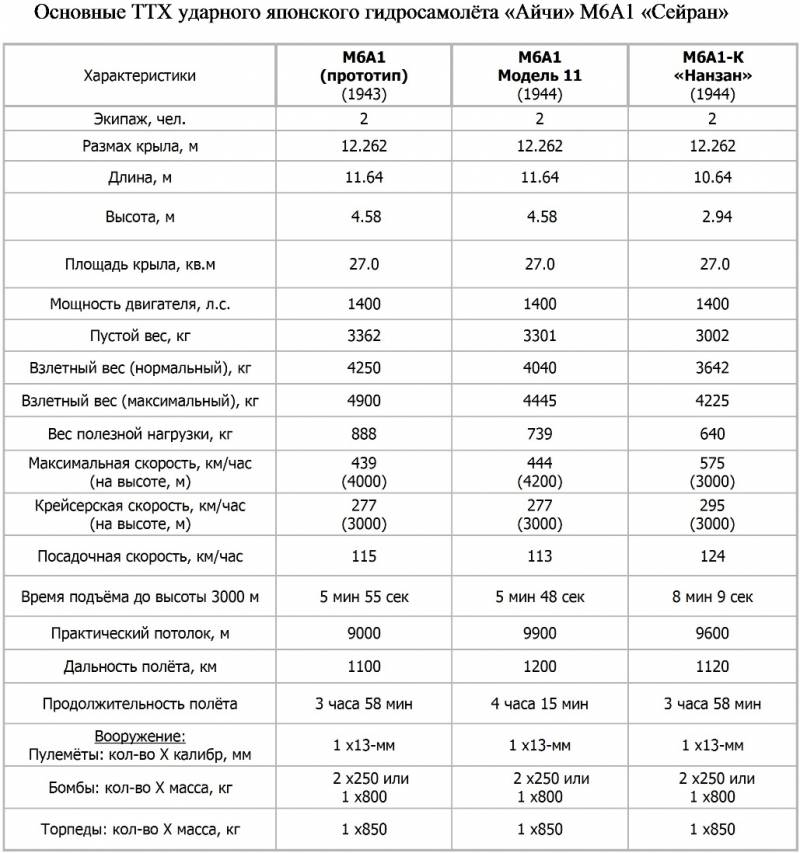
Information